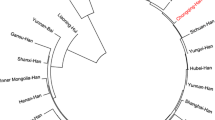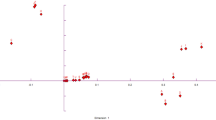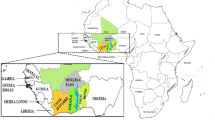Abstract
Genotyping of highly polymorphic short tandem repeat (STR) markers is widely used for the genetic identification of individuals in forensic DNA analyses and in paternity disputes. The National DNA Profile Databank recently established by the DNA Identification Act in Korea contains the computerized STR DNA profiles of individuals convicted of crimes. For the establishment of a large autosomal STR loci population database, 1805 samples were obtained at random from Korean individuals and 15 autosomal STR markers were analyzed using the AmpFlSTR Identifiler PCR Amplification kit. For the 15 autosomal STR markers, no deviations from the Hardy-Weinberg equilibrium were observed. The most informative locus in our data set was the D2S1338 with a discrimination power of 0.9699. The combined matching probability was 1.521 × 10−17. This large STR profile dataset including atypical alleles will be important for the establishment of the Korean DNA database and for forensic applications.
Similar content being viewed by others
References
Budowle, B., Moretti, T.R., Baumstark, A.L., Defenbaugh, D.A., and Keys, K.M. (1999). Population data on the thirteen CODIS core short tandem repeat loci in African Americans, U.S, Caucasians, Hispanics, Bahamians, Jamaicans and Trinidadians. J. Forensic Sci. 44, 1277–1286.
Budowle, B., Shea, B., Niezgoda, S., and Chakraboty, R. (2001). CODIS STR loci data from 41 sample populations. J. Forensic Sci. 46, 453–489.
Butler, J.M. (2006). Genetics and genomics of core short tandem repeat loci used in human identity testing. J. Forensic Sci. 51, 253–265.
Cho, N.S., Kang, G.H., Lee, S.Y., Park, I.H., and Seo, J.S. (2006). Population database on nine STR loci of the AmpFℓSTR Profiler kit in Koreans. Legal Med. 8, 55–57.
Clayton, T.M., Guest, J.L., Urquhart, A.J., and Gill, P.D. (2004). A genetic basis for anomalous band patterns encountered during DNA STR profiling. J. Forensic Sci. 49, 1207–1214.
Dauber, E.M., Schwartz-Jungl, E.M., Wenda, S., Dorner, G., Glock, B., and Mayr, W.R. (2009). Further allelic variation at the STRloci ACTBP2 (SE33), D3S1358, D8S1132, D18S51 and D21S11. Forensic Sci. Int. Genet. (Suppl. 2), 41–42.
Egyed, B., Furedi, S., Angyal, M., Boutrand, L., Vandenberghe, A., Woller, J., and Padar, Z. (2000). Analysis of eight STR loci in two Hungarian populations. Forensic Sci. Int. 113, 25–27.
Excoffier, L., and Lischer, H. (2010). Arlequin suite ver 3.5: a new series of programs to perform population genetics analyses under Linux and Windows. Mol. Ecol. Res. 10, 564–567.
Fisher, R.A. (1951). Standard calculations for evaluating a blood group system. Heredity 5, 95–102.
Freeman, J.L., Perry, G.H., Feuk, L., Redon, R., McCarroll, S.A., Altshuler, D.M., Aburatani, H., Jones, K.W., Tyler-Smith, C., Hurles, M.E., et al. (2006). Copy number variation: new insights in genome diversity. Genome Res. 16, 949–961.
Fridman, C., Santos, P.C.C., Kohler, P., Garcia, C.F., Lopez, L.F., Massad, E., and Gattás, G.J.F. (2008). Brazilian population profile of 15 STR markers. Forensic Sci. Int. Genet. 2, e1–e4.
Hammond, H.A., Jin, L., Zhong, Y., Caskey, C.T., and Chackraborty, R. (1994). Evaluation of 13 short tandem repeat loci for use in personal identification applications. Am. J. Hum. Genet. 55, 175–189.
Han, G.R., Lee, Y.W., Lee, H.L., Kim, S.M., Ku, T.W., Kang, I.H., Lee, H.S., and Hwang, J.J. (2000). A Korean population study of the nine STR loci FGA, VWA, D3S1358, D18S51, D21S11, D8S1179, D7S820, D13S317 and D5S818. Int. J. Legal Med. 114, 41–44.
Han, M.S., Hong, S.B., Choi, S.K., Cho, Y.H., Jin, H.J., Kwak, K.D., and Kim, W. (2002). Population genetics data on thirteen CODIS short tandem repeat loci in Koreans. Korean J. Genet. 24, 83–87.
Kim, Y.L., Hwang, J.Y., Kim, Y.J., Lee, S., Chung, N.G., Goh, H.G., Kim, C.C., and Kim, D.W. (2003). Allele frequencies of 15 STR loci using AmpF/STR Identifiler kit in a Korean population. Forensic Sci. Int. 136, 92–95.
Lee, H.R., Bae, I.H., Park, S.W., Kim, H.J., Min, W.K., Han, J.H., Kim, K.T., and Kim, B.D. (2009). Construction of an integrated pepper map using RFLP, SSR, CAPS, AFLP, WRKY, rRAMP, and BAC end sequences. Mol. Cells 27, 21–37.
Li, C., Li, L., Zhao, Z., Lin, Y., Que, T., Liu, Y., and Xue, J. (2009). Genetic polymorphism of 17 STR loci for forensic use in Chinese population from Shanghai in East China. Forensic Sci. Int. Genet. 3, e117–e118.
Martin, P.D. (2004). National DNA databases: practice and practicability. A forum for discussion. Prog. Forensic Genet. 10, 1–8.
Nie, S., Yao, J., Yan, H., Yang, Y., Gu, T., Tang, W., Li, W., Wang, B., and Xiao, C. (2008). Genetic data of 15 STR loci in Chinese Yunnan Han population. Forensic Sci. Int. Genet. 3, e1–e3.
Park, S.J., Woo, K.M., Oh, H.H., Kim, S.H., and Lee, S.H. (2005). Population data of the 25 STR loci in Koreans. J. Forensic Sci. 50, 710–712.
Sánchez-Diz, P., Menounos, P.G., Carracedo, A., and Skitsa, I. (2008). 16 STR data of a Greek population. Forensic Sci. Int. Genet. 2, e71–e72.
Tautz, D. (1989). Hypervariability of simple sequence as a general source for polymorphic DNA markers. Nucleic Acids Res. 17, 6463–6471.
Tsuji, A., Ishiko, A., and Ikeda, N. (2006). The structure of a variant allele which is considered to be 30.3 in the STR locus D21S11. Legal Med. 8, 182–183.
Weir, B.S. (1990). Multiple tests, genetic data analysis II, (Sinauer Associates, USA), pp. 109–110.
Author information
Authors and Affiliations
Corresponding author
Additional information
These authors contributed equally to this work.
About this article
Cite this article
Yoo, S.Y., Cho, N.S., Park, M.J. et al. A large population genetic study of 15 autosomal short tandem repeat loci for establishment of Korean DNA Profile Database. Mol Cells 32, 15–19 (2011). https://doi.org/10.1007/s10059-011-2288-4
Received:
Revised:
Accepted:
Published:
Issue Date:
DOI: https://doi.org/10.1007/s10059-011-2288-4




